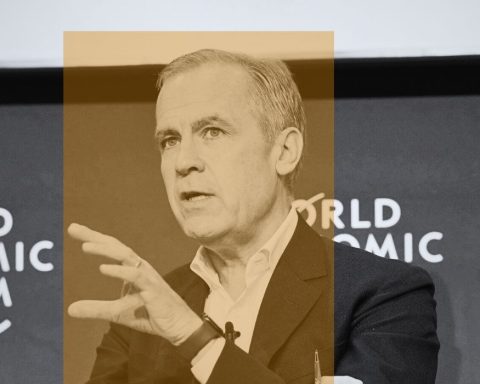Standing at the corner of University Avenue and Dundas Street in downtown Toronto provides a familiar sight for Canadians: an RBC branch, a BMO branch and a CIBC branch. Beleaguered customers of either TD or Scotiabank will have to walk an extra block.
In contrast with the top five banks in the United States, which hold just over a third of the market, Canada’s Big Five famously dominate around 90% of the market for financial services. They’re also some of the most profitable on the planet, with their Canadian personal and commercial banking services regularly notching profit margins north of 30%.
This is the basic unwritten structure of the arrangement: in exchange for offering economic stability (largely avoiding the agony of this century’s financial crisis), Canadian banks are allowed to occupy an unchallenged position in our economy.
But what do average Canadians get out of this bargain, and where do those world-leading profits come from? Amid a once-in-a-generation cost-of-living crisis, there is heightened scrutiny of the ways Canadians’ lives are made more expensive, big and small. Despite signs that inflation is dropping, and with the Bank of Canada expected to cut interest rates by the end of the year, many Canadians are still struggling. All the while, Canadian banks are quietly pulling in billions a year on a yawning gap between the rates paid to savers and charged to borrowers.
The joy of fees
Banks essentially make money in two ways: interest income and non-interest income. Interest income is the interest made on a dollar loaned to you minus the interest paid on the dollars you loan the bank – your hard-earned deposits. Non-interest income is a broader category, but to everyday Canadians the most common instance of non-interest income is fees.
There is no interacting with Canada’s financial system without the ever-present joy of fees. There are fees to open accounts, fees to close accounts, fees to keep accounts open, fees to send and even to receive money, and the adding-insult-to-injury fees for not having enough money in your account. Fees are serious business for the banks, with non-interest income for the Big Five topping more than $17 billion in Canada last year, according to public financial statements. Not only have the average total fees Canadians pay on an inflation-adjusted basis over the past decade increased, but so too has the portion of Canadian bank earnings coming from non-interest income.
In a comparison with the U.K. banking sector, Canadian economic consulting firm North Economics estimated that Canadians are overpaying to the tune of $8.5 billion more in fees annually than the equivalent fees of our British counterparts. North Economics blames coordination between major banks and a lack of competition for these higher fees, as well as relatively lower quality of banking product offerings. Looking at non-sufficient-funds (NSF) fees, the charges incurred when a chequing account is overdrawn, North Economics sees in the divorce between fees and the cost to deliver the service “a clear example of sustained oligopolistic coordination.”
If banks are coordinating, even tacitly, on how they earn non-interest income, the same behaviour could be shaping what’s on offer for Canadian savers and borrowers when it comes to interest income, too.
Interest galore
Those who have shopped around for a line of credit would likely be familiar with the phrase “prime plus X,” while potential homeowners might be more accustomed to “prime minus Y.” The “prime rate” for bank lending products is based on the overnight lending rate of the Bank of Canada. Historically, the Big Five have all maintained the same prime rate, moving in lockstep in the days following a Bank of Canada interest rate announcement, with some level of differentiation in the posted rates for individual products like mortgages.
One critical detail that has changed is the spread between the Bank of Canada’s overnight interest rate and the prime rate used by the banks to set the rate for lending products. Since the early 2000s, that distance has quietly grown from 175 basis points (a basis point is a percent of a percent, with 175 basis points translating to 1.75%) to 220. Most average loan seekers wouldn’t have noticed that widening distance between the rate charged on lending from the Bank of Canada and the rates at which the banks lend to Canadians. While the Bank of Canada lowered its rates to historic lows during this time, we didn’t see a proportional shrinking of these spreads. In fact, they grew. This represents an almost imperceptible squeeze on Canadians as our savings do less work for us while the rates at which we borrow money rise.
After nearly 15 years of rock-bottom interest rates since the financial crisis and the COVID-19 pandemic, the rising rates of the past two years provide a useful example of how those interest rate changes are passed on to consumers. When it comes to lending rates, the banks are quick to pass on the full cost of rate rises without delay. Take the last rate hike in July of 2023, where each of the Big Five banks passed on the full 25-basis-point raise to their posted five-year variable mortgages the day after the hike. Since early 2022, the Bank of Canada has raised interest rates by 475 basis points, rates for five-year variable mortgages have risen by more than 500 basis points, and rates for five-year fixed mortgages have risen by approximately 300 basis points on average.
Canadians are overpaying to the tune of $8.5 billion more in fees annually than the equivalent fees of our British counterparts.
Personal savings accounts, on the other hand, have not seen similar increases from their pandemic lows, with regular savings rates stubbornly stuck below 2%. That growing spread between lending and savings rates, known as net interest margins (NIM), is driving net interest income, with some banks growing their margins by as much as 15%. Though banks deal in percents of percents, when applied to their trillion-dollar asset bases these small moves translate into billions more of interest income flowing into banks annually. Those growing margins accounted for another $1.4 billion in interest income for the Big Five in just the first quarter of 2024 and more than $5 billion since rates started rising in early 2022, according to analysis of financial statements.
The structure of Canada’s oligopoly markets also affects how customers are treated on an individual basis. In a recent CBC Marketplace report, the broadcaster found a systematic pattern of Big Five bank employees being pushed to mislead customers into purchasing financial products they didn’t need to meet corporate performance targets. CBC conducted a similar investigation in 2017 and received more than 3,000 testimonies from TD Bank employees about aggressive and misleading sales practices. Customers upset about being misled by their banks are faced with the annoyance of manually shifting their financial lives to another oligopoly player who may already be pushing its own staff to act in a similarly cavalier way.
Unfortunately, we are headed in the wrong direction on banking competition in Canada. RBC, by several measures Canada’s largest financial institution and corporate entity, was allowed to purchase HSBC Canada after the British-based international banking conglomerate put several of its global outposts on sale. In approving the transaction, the federal government allowed the takeover of a competitor that had differentiated itself in the market for mortgages and international banking, according to the Competition Bureau. That kind of competition could have exerted pressure on expanding interest margins while Canadians shop around more aggressively as monthly mortgage payments rise.
Most average loan seekers wouldn’t have noticed that widening distance between the rate charged on lending from the Bank of Canada and the rates at which the banks lend to Canadians.
Recognizing that the banks made outsized profits during the pandemic, the government introduced a one-time tax on the average profits above $1 billion for the 2020 and 2021 fiscal years. But while fair taxation is a cornerstone of a fair society, the move does nothing to change the conditions for Canadians’ everyday navigation of the financial system.
Thankfully this focus appears to be shifting toward opening up competition in the financial sector. In the most recent fall economic statement, the federal government committed to introducing legislation to give consumers greater control over their financial data, making the process of switching to competing banks easier. Neither of these changes represent groundbreaking shifts in Canada’s approach to its banks, but they create the foundation to rebalance the relationship between them and Canadian savers and borrowers.
Canada’s monopoly problem is not limited to the banking sector, but improvements here will ripple throughout the economy. In the landmark 1960s Philadelphia National Bank case before the U.S. Supreme Court, Justice William Brennan noted that concentration in the financial sector is a recipe for concentration in the broader economy. Looking across our economy, there are few markets that refute this proposition. If Canada wishes to break from the economic path that has led to less competition and fewer options across the economy, we should start with a hard look at the sector at the foundation of our economy.
Keldon Bester is the executive director of the Canadian Anti-Monopoly Project, a fellow at the Centre for International Governance Innovation, and a former special advisor at the Competition Bureau.
Photo illustration by Jack Dylan.






